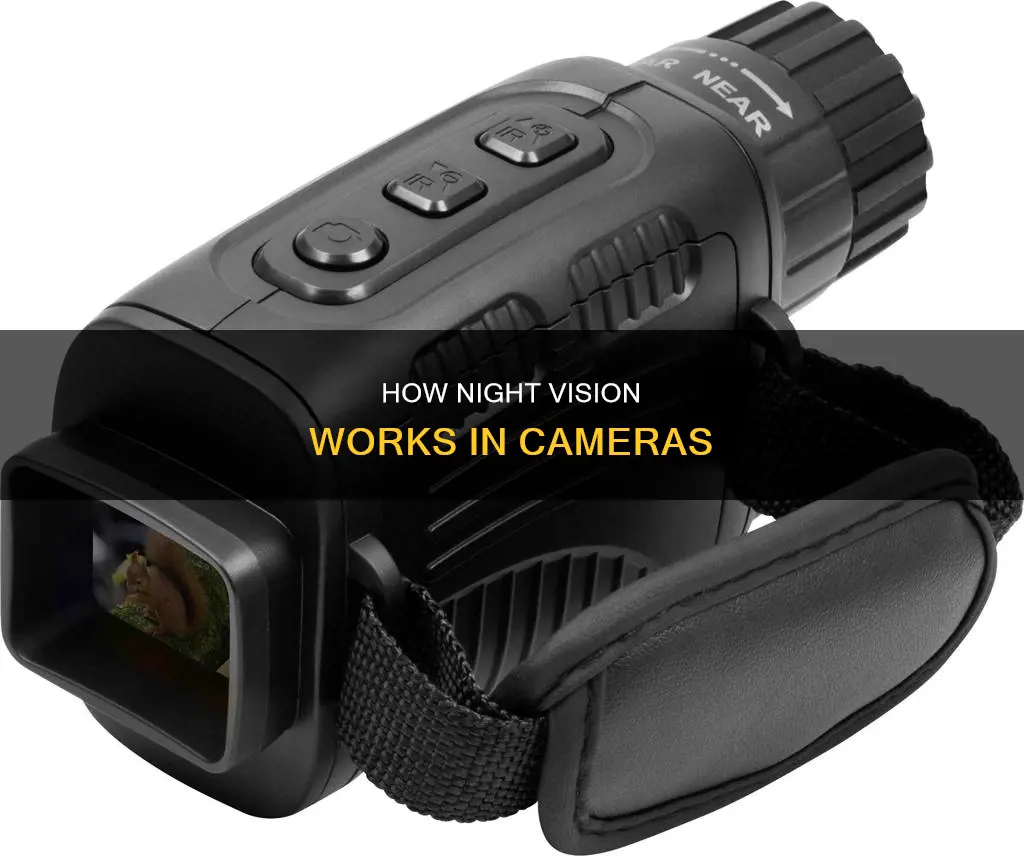
Night vision cameras are commonly used for surveillance and security, and they have become increasingly popular with civilians, especially for home security. They can be used in complete darkness, but how do they work? Night vision cameras use natural light sources such as the moon, or they rely on infrared light, which is invisible to the naked eye. Infrared night vision illuminates the area with infrared light, which is then captured by the camera's sensor. This allows the camera to create a clear image, even in low-light conditions. The exact viewing range of a night vision camera depends on various factors, such as lighting conditions and lens aperture, but on average, they can see between 100 to 200 feet in the dark.
| Characteristics | Values |
|---|---|
| Average range | 100-200ft |
| Lighting conditions | Sufficient spectral range and sufficient intensity range |
| Technology | Infrared, low-light, thermal imaging |
| Image | Black and white, monochrome, green phosphor, colour |
| Power | Battery-powered or wired |
| Durability | Weatherproofing, higher IP-rated cameras |
What You'll Learn

Infrared Night Vision
Night vision is the ability to see in low-light conditions, either naturally or through a night-vision device. Humans have poor night vision compared to many animals, as the human eye lacks a tapetum lucidum—a tissue behind the retina that reflects light back, increasing the light available to the photoreceptors.
Night vision devices (NVDs) can be divided into three categories: image intensification, active illumination, and thermal imaging. Image intensification magnifies the amount of received photons from various natural sources such as starlight or moonlight. Active illumination couples imaging intensification with an active source of illumination in the near-infrared (NIR) or shortwave infrared (SWIR) band. Thermal imaging detects temperature differences between foreground and background objects.
Infrared (IR) night vision is the most common type of night vision used in security cameras. It relies on IR light to function, bathing the area in light that is invisible to the human eye. This is achieved through IR LEDs, which act as a floodlight of sorts, dousing the camera's field of view with IR light. As IR light is invisible to humans, it does not unmask the user or interfere with others' activities. Security cameras with IR night vision can capture clear black-and-white images, making them suitable for surveillance in low-light conditions.
IR night vision is also used in night-vision goggles, which contain intensifier tubes that amplify the available light. The light entering the goggles (consisting of photons) is turned into electrons, which are then multiplied using a photomultiplier and passed through a phosphor screen, creating a brighter image. The resulting image appears in shades of green, as human eyes are much more sensitive to green than other colours.
Stream Unifi Cameras on Apple TV: Easy Steps
You may want to see also

Low-Light Night Vision
Night vision is the ability to see in low-light conditions, either naturally or with the help of a night-vision device. Low-light night vision security cameras can capture high-quality photos and videos in very dark conditions. This is made possible by their sensitive starlight sensors and wide apertures. These cameras are also equipped with features like motion sensors, infrared night vision, and long battery life.
The digital amplification method, on the other hand, produces better results than the optoelectronic method. It also has a faster process, eliminating any delays or stuttering when viewing fast-paced scenes. Another advantage of digital amplification is the ability to use additional functionality, allowing the camera to adapt to the user's individual needs.
LG TV Camera: What You Need to Know
You may want to see also

Image Enhancement
The image enhancement process begins with the lens, which collects the available light and sends it to a unique converter. This converter contains a CMOS sensor that turns the light information into a digital signal. This process, which takes just fractions of a second, is crucial in forming the final image. Once the light information is converted, the image is enhanced by an electronic system, which increases its sharpness and brightness while removing any defects. The final image is then sent to the display.
While image enhancement is the most common technology used in night vision devices, thermal imaging is another technique that captures the upper portion of the infrared light spectrum. This technology is based on the heat emitted by objects rather than reflected light.
Camera Eclipse Viewing: Is It Safe?
You may want to see also

Thermal Imaging
Thermal imagers detect tiny differences in heat, as small as 0.01°C, and display them as shades of grey or with different colours. For example, a thermal imaging camera may display the cooler parts of an object as blue and the hotter parts as red. This allows users to see objects that give off even small amounts of heat, such as a person hiding in bushes, even in complete darkness.
Overall, thermal imaging technology offers a unique perspective that enhances human perception and provides valuable insights across various fields, from security and surveillance to energy efficiency and wildlife observation.
Hidden Cameras: Watching Youngsters, Safely and Securely
You may want to see also

Active Illumination
Active infrared night vision is commonly used in commercial, residential, and government security applications, where it enables effective nighttime imaging in low-light conditions. However, one drawback is that since active infrared light can be detected by night-vision goggles, there is a risk of giving away a position in tactical military operations.
The spectral range used by active illumination is 700 nm to 1000 nm, which is just below the light spectrum visible to the human eye. This is why active illumination cannot be seen with the naked eye alone. Active illumination is commonly used in night vision devices for household, government, and commercial applications, particularly in surveillance and security cameras.
One of the key advantages of active illumination is its ability to provide a wide range of high visibility, even in places with heavy snowfall, fog, smoke, or rainfall. This makes it a very beneficial type of night vision technology for a variety of use cases. Active illumination can also be used to capture video footage of fast-moving vehicles, making it useful for road surveillance.
Finding TV Cameras: Techniques for Spotting Hidden Lenses
You may want to see also
Frequently asked questions
Night vision is the ability to see in low-light conditions, either naturally or through a night-vision device.
Night vision works by collecting tiny amounts of light, including the lower portion of the infrared light spectrum, and amplifying it to the point that we can easily observe the image.
There are three main types of night vision: image intensification, active illumination, and thermal imaging.
On average, night vision security cameras can see in a range between 100 to 200ft.
Night vision cameras are useful for home security, business surveillance, and outdoor recreation. They can help identify intruders, monitor wildlife, and navigate in low-light conditions.







